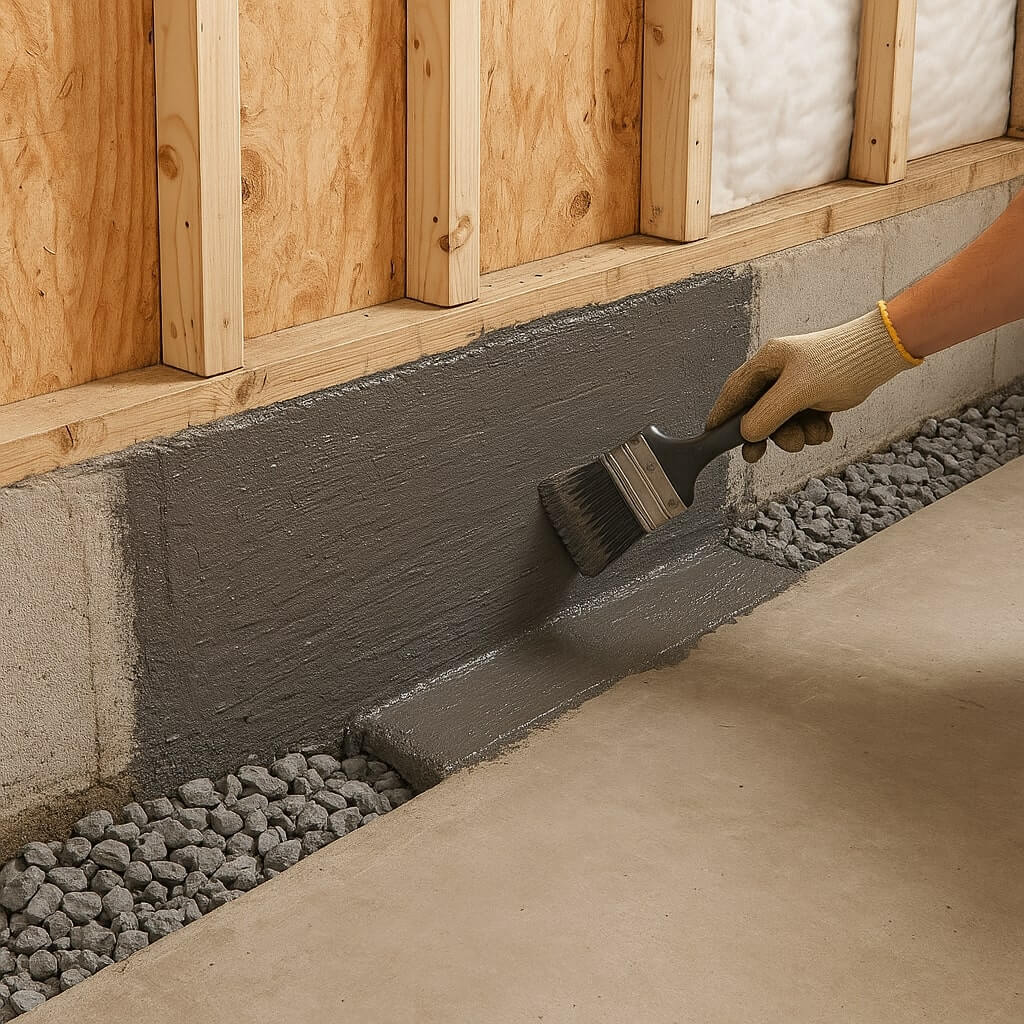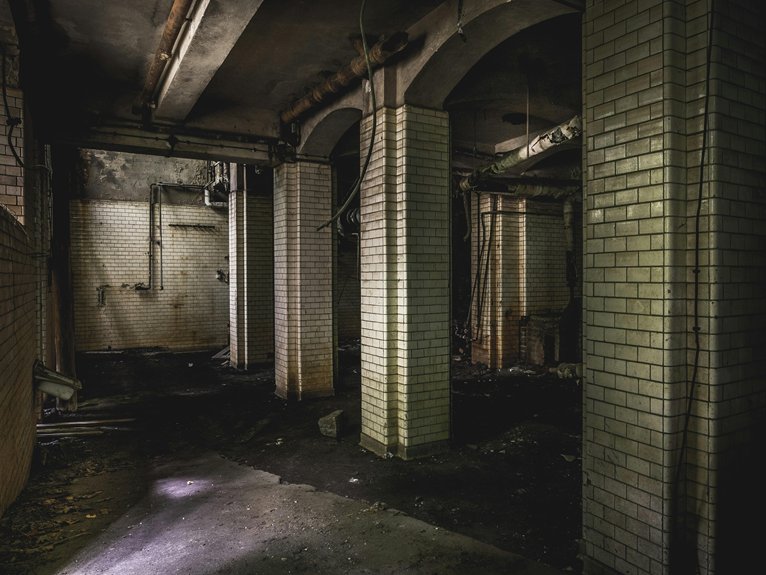When it comes to protecting your wood basement from moisture, understanding the right techniques is crucial. You’ll want to assess vulnerabilities and implement effective drainage solutions. This includes using vapor barriers and sealing cracks to prevent water intrusion. Regular maintenance and inspections are important too. But how do you know when it’s time to call in a professional? Let’s explore these waterproofing strategies to keep your basement safe and dry.
Key Takeaways
- Inspect for moisture sources and use detection tools to assess humidity levels in wood basements.
- Implement effective drainage solutions like French drains and sump pumps to divert water away.
- Use vapor barriers made from polyethylene to shield against moisture in vulnerable areas.
- Apply waterproofing paints, such as elastomeric or bituminous, following proper preparation and application techniques.
- Conduct regular maintenance and inspections to identify and address potential issues early.
Understanding the Importance of Waterproofing

Waterproofing is essential for protecting your home’s foundation and maintaining a healthy living environment.
When moisture seeps into your wood basement, it can lead to severe water damage, compromising the integrity of your home. By implementing effective moisture control techniques, you can prevent mold growth and structural issues.
Moisture intrusion in your wood basement can cause significant damage and promote mold growth, risking your home’s integrity.
Start by sealing any cracks or gaps in the foundation and ensuring proper drainage around your property. Consider using a vapor barrier to keep moisture at bay.
Regularly inspect your basement for signs of dampness, and address issues promptly to safeguard your home and enhance your living conditions.
Don’t take waterproofing lightly!
Assessing Your Wood Basement for Vulnerabilities
To effectively waterproof your wood basement, start by inspecting for moisture sources like leaks or damp spots.
Next, check the structural integrity of the wood, looking for signs of rot or damage that could worsen over time.
Addressing these vulnerabilities early can save you from costly repairs down the line.
Inspect for Moisture Sources
How can you effectively identify the moisture sources lurking in your wood basement? Start with moisture detection tools like a hygrometer or moisture meter to measure humidity levels in the air and wood.
Inspect walls, floors, and ceilings for visible signs of leaks, such as water stains or mold growth. Pay close attention to windows, pipes, and any cracks in the foundation that could lead to leak identification.
Don’t forget to check gutters and downspouts outside, as poor drainage can contribute to moisture issues. By thoroughly evaluating these areas, you’ll pinpoint vulnerabilities and take necessary action to prevent water damage.
Check Structural Integrity
While evaluating your wood basement for vulnerabilities, checking the structural integrity is essential to guarantee your space remains safe and dry.
Start by inspecting the foundation for cracks or signs of shifting, as these can compromise foundation stability. Look for any sagging beams or weakened joists, which may need structural reinforcements.
Pay attention to the connections between walls and the floor; any gaps can lead to moisture intrusion. Regularly reviewing these areas not only helps prevent water damage but also assures your basement remains a secure area for storage or living space.
Don’t overlook these critical aspects in your waterproofing efforts.
Effective Drainage Solutions
Effective drainage solutions are essential for preventing water intrusion in your basement, especially if you live in an area prone to heavy rainfall or flooding. Implementing effective drainage systems can greatly improve water diversion away from your foundation. Consider installing a French drain, which channels water away from your property. You might also explore gutter extensions to direct rainwater away from the house. Here’s a quick reference table:
| Solution | Description |
|---|---|
| French Drain | A trench filled with gravel to divert water |
| Gutter Extensions | Extensions that direct water further from the foundation |
| Sump Pump | Pumps water out of the basement |
| Downspout Diverters | Redirects roof runoff away from the base |
Using Vapor Barriers to Prevent Moisture
After ensuring proper drainage around your basement, the next step in moisture control involves installing vapor barriers.
These barriers, often made from polyethylene or foil-faced insulation, act as a shield against moisture. For effective installation, start by measuring the area and cutting the vapor barrier materials to fit.
Use adhesive or tape to seal all seams and edges tightly, ensuring no gaps remain. Pay special attention to corners and joints, as these are vulnerable points.
Sealing Cracks and Joints
To prevent moisture infiltration, sealing cracks and joints in your basement is essential.
Start with a thorough inspection to identify any visible cracks or gaps. For effective crack repair, use a high-quality epoxy or polyurethane sealant, applying it generously to guarantee full coverage.
When it comes to joint sealing, focus on areas where walls meet the floor or other structural components. Clean the surfaces thoroughly before applying sealant to achieve a strong bond.
Allow the materials to cure as directed, assuring a tight seal that stops moisture in its tracks. Regular maintenance checks will help keep your basement dry and safe.
Choosing the Right Waterproofing Paints
When selecting waterproofing paints for your wood basement, it’s essential to understand the different types available, such as acrylic, epoxy, and latex options.
Each type has unique properties and application methods that can greatly impact your results.
To guarantee a successful application, you’ll need to follow specific techniques and tips tailored to the paint you choose.
Types of Waterproofing Paint
Choosing the right waterproofing paint can make all the difference in protecting your basement from moisture damage. Understanding paint types is essential to maximize the waterproofing benefits. Here’s a quick comparison:
| Paint Type | Benefits | Ideal Use |
|---|---|---|
| Acrylic Latex | Flexible, easy to apply | Interior walls |
| Elastomeric | High elasticity | Exterior walls |
| Bituminous | Excellent moisture barrier | Foundation applications |
Selecting the appropriate paint type can greatly enhance your basement’s resilience against water intrusion, ensuring a dry and secure environment.
Application Techniques and Tips
Although it might seem straightforward, applying waterproofing paint requires careful attention to detail to guarantee the finest results.
Start with thorough preparation steps: clean the surface, remove any peeling paint, and fill cracks.
Choose the right application methods—brushes, rollers, or sprayers—based on your project’s size and complexity.
For best adhesion, apply the paint in thin, even coats, allowing each layer to dry completely before adding another.
Don’t forget to check the weather; dry conditions yield ideal results.
Follow the manufacturer’s instructions for specific curing times and reapplication, ensuring your wood basement remains protected from moisture over time.
Installing a Sump Pump
Installing a sump pump can be a game-changer for keeping your basement dry and protected from flooding. Understanding different sump pump types—submersible, pedestal, and battery backup—helps you choose the right one. During sump pump installation, follow these steps:
| Step | Description | Tip |
|---|---|---|
| 1. Choose Pump | Select pump based on needs | Check horsepower ratings |
| 2. Dig Pit | Excavate a hole for the basin | Guarantee proper drainage |
| 3. Connect | Attach discharge pipe | Position away from home |
With the right sump pump, you’ll safeguard your basement from water damage.
Improving Ventilation in Your Basement

When it comes to maintaining a dry and healthy basement, improving ventilation is essential for preventing moisture buildup and mold growth.
Start by enhancing basement air circulation with exhaust fans or vents that allow fresh air in while pushing stale air out. You can also install a dehumidifier to aid in humidity control, keeping moisture levels in check.
Confirm that air ducts are clean and unobstructed, maximizing airflow. Additionally, consider opening windows during dry days to promote natural ventilation.
Regular Maintenance and Inspections
To keep your basement dry and free from water damage, regular maintenance and inspections are essential. Implementing preventive measures through routine check-ups can save you from costly repairs down the line. Check for leaks, mold, and moisture levels at least twice a year. Here’s a quick reference table for your maintenance tasks:
| Task | Frequency | Purpose |
|---|---|---|
| Inspect gutters | Twice a year | Prevent water overflow |
| Check sump pump | Monthly | Guarantee proper operation |
| Look for cracks | Annually | Identify potential leaks |
Stay proactive, and your basement will remain protected!
Professional Help: When to Call an Expert
If you notice signs of serious damage, like mold growth or warped wood, it’s time to call an expert.
Tackling complex waterproofing solutions requires specialized knowledge and tools that you mightn’t have.
Don’t hesitate to seek professional help when the situation exceeds your DIY capabilities—it can save you time and money in the long run.
Signs of Serious Damage
While many homeowners can handle minor leaks or dampness in their basements, recognizing the signs of serious damage is essential to preventing extensive and costly repairs.
Look for wood damage, such as warping, discoloration, or soft spots, which may indicate prolonged exposure to moisture.
Pay attention to moisture indicators like mold growth or musty odors, as these can signal hidden issues.
If you notice persistent water stains on walls or ceilings, it’s time to take action.
When these signs appear, don’t hesitate to call an expert to assess the situation and implement effective waterproofing solutions before the problem worsens.
Complex Waterproofing Solutions
After identifying signs of serious damage in your basement, addressing the issue promptly can save you from more extensive problems down the line.
If you’re facing complex waterproofing challenges, it’s often best to call in an expert. They can implement advanced sealing techniques that are essential for long-term protection.
Additionally, professional help can design and install effective drainage systems tailored to your basement’s specific needs.
DIY solutions may not provide the durability required to combat severe water intrusion.
Don’t hesitate to seek professional advice; it can ultimately save you time, money, and stress in the future.
Conclusion
By implementing these essential wood basement waterproofing techniques, you can greatly reduce the risk of moisture damage and mold growth. Regular inspections and maintenance will help you stay ahead of potential issues, ensuring a safe, healthy living environment. Don’t hesitate to use effective drainage solutions, vapor barriers, and sealants to protect your investment. If you encounter serious problems, calling a professional can provide you with the expertise needed to keep your basement dry and secure for years to come.




